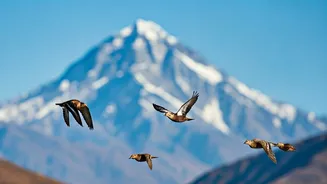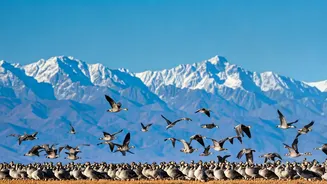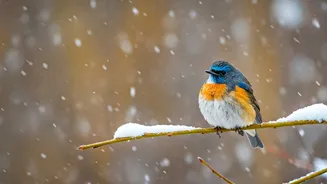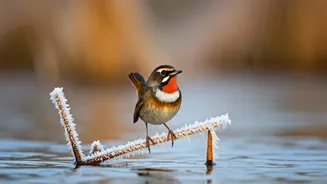Siberian Cranes' Journey
The Siberian Crane, also known as the white crane, makes an extraordinary journey, covering thousands of kilometers. This majestic bird typically travels
from Siberia to India during winter, seeking warmer climates and food sources. The cranes once frequented Keoladeo National Park in Rajasthan, where they found a suitable habitat. Unfortunately, their numbers have significantly declined, making sightings rare. Conservation efforts are crucial to protect this species and ensure their return to India's wetlands. Their presence is a sign of ecological health, and their migration story is a testament to nature's resilience and the importance of preserving their habitats.
Amur Falcons' Aerial Show
Amur Falcons are renowned for their incredible migratory flights, traveling vast distances from eastern Siberia and China to southern Africa. They make a pit stop in India, particularly in the northeastern states, where they gather in large numbers. These falcons are notable for their aerial acrobatics, often congregating in vast flocks. Nagaland is a prime location to observe their impressive congregations, where they can be seen perched on power lines and trees. The journey and behavior of the Amur Falcon underscore the global interconnectedness of ecosystems and the need for international collaboration in conservation efforts. Locals play a key role in protecting them.
Bar-headed Geese's Passage
The Bar-headed Goose is a high-altitude migrant, famed for its ability to fly over the Himalayas. They journey from Central Asia to various parts of India, including wetlands, lakes, and agricultural areas. These geese are incredibly hardy, able to endure the harsh conditions of high-altitude flight. They are particularly drawn to areas with open water and grasslands, where they can feed and rest. Their presence is a symbol of resilience and adaptation, showcasing their ability to thrive in challenging environments. Many regions such as Ladakh, are key spots where one can spot these beautiful birds during the winters.
Greater Flamingos' Spectacle
The Greater Flamingo is known for its elegant appearance and striking pink plumage. During winter, they migrate to India, congregating in large numbers in coastal areas, salt marshes, and shallow lagoons. The Rann of Kutch in Gujarat is a prime location to witness their magnificent gatherings. These birds add color and life to the landscape, with their synchronized feeding and graceful movements. Their presence enhances the ecological richness of the areas they visit. They feed on algae and small invertebrates, contributing to the balance of these unique ecosystems. Their pink hue is a striking contrast against the backdrop of the wetlands.
Bluethroats' Songful Visit
Bluethroats, small passerine birds, are notable for their colorful throats and melodious songs. They migrate from Siberia and Europe to India, seeking warmer climates and plentiful food sources. They can be found in a variety of habitats, including grasslands, scrublands, and reedbeds. Their presence often indicates the presence of varied insect populations. These delightful birds add to the natural symphony of the Indian winter landscape, with their cheerful songs. Their adaptability and varied diet make them a valuable part of their ecosystem. The Bluethroat’s migration journey underscores the interconnectedness of various ecosystems.














